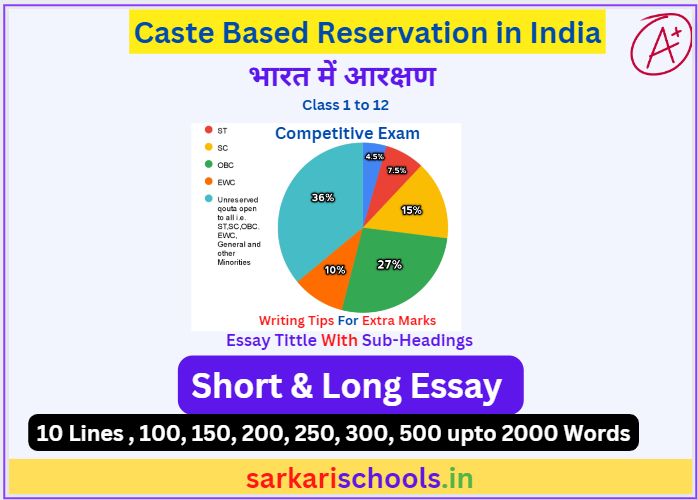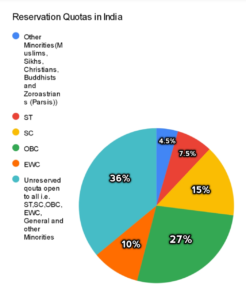Essay On Caste Based Reservation System in India of affirmative action that aims to provide equal opportunities for members of historically disadvantaged castes and tribes. It was introduced after India’s independence in 1947 to address the deep-rooted social and economic discrimination faced by these communities.
Table of Contents

Essay On Caste Based Reservation System in India
Introduction:
Caste-based reservation, commonly known as affirmative action or positive discrimination, has been a significant and contentious policy in India aimed at addressing historical social injustices and promoting equal opportunities for all citizens. The reservation system was introduced as a temporary measure to uplift marginalized communities, primarily Scheduled Castes (SCs), Scheduled Tribes (STs), and Other Backward Classes (OBCs). While proponents argue that it has played a pivotal role in empowering historically disadvantaged groups, critics raise concerns about its long-term effectiveness, potential perpetuation of caste identities, and impacts on meritocracy.
Types of Reservation
There are three main categories of caste-based reservation in India:
- Scheduled Castes (SCs): These are the lowest castes in the traditional Hindu social hierarchy, and they have historically been the most marginalized group in Indian society.
- Scheduled Tribes (STs): These are indigenous communities living in India, and they have often been subjected to exploitation and violence.
- Other Backward Classes (OBCs): This category is defined by the government of India, and it includes castes and tribes that are socially and educationally backward.
Percentage of Reservation
| Category | Percentage of Reservation |
|---|---|
| Scheduled Castes (SCs) | 15% |
| Scheduled Tribes (STs) | 7.5% |
| Other Backward Classes (OBCs) | 27% |

The percentage of reservation for each category varies depending on the context. In government jobs, the reservation for SCs is 15%, for STs is 7.5%, and for OBCs is 27%. In higher education institutions, the reservation for SCs and STs is 22.5%, and for OBCs is 50%.
Purpose of Reservation
The purpose of caste-based reservation is to provide historically disadvantaged castes and tribes with equal opportunities for education and employment. By reserving a certain percentage of seats in schools, colleges, and government jobs for these communities, the government hopes to break the cycle of poverty and discrimination that has plagued them for centuries.
Arguments for and Against Reservation
Caste-based reservation is a controversial issue in India, and there are strong arguments for and against it.
Arguments in favor of reservation:
- It is a necessary measure to address the deep-rooted social and economic discrimination faced by historically disadvantaged castes and tribes.
- It has helped to improve the social and economic status of these communities.
- It has led to greater representation of marginalized groups in government and other institutions.
Arguments against reservation:
- It creates resentment and division among different caste groups.
- It perpetuates the caste system by reinforcing the idea that certain castes are superior to others.
- It discriminates against individuals based on their caste rather than their merit.
The Future of Reservation
The future of caste-based reservation in India is uncertain. The system is constantly under scrutiny, and there is a growing debate about whether it should be extended or abolished.
Some argue that reservation should be phased out gradually as the social and economic conditions of historically disadvantaged castes improve. Others argue that reservation is an essential measure to ensure that these communities have a fair chance of success in society.
Historical Context:
The roots of caste-based reservation can be traced back to the Indian Constitution, which was adopted in 1950. Dr. B.R. Ambedkar, the principal architect of the Constitution and a champion for the rights of Dalits (formerly untouchables), advocated for affirmative action to rectify centuries of discrimination. The reservation system was initially implemented for a period of ten years but has been extended multiple times, reflecting the persistent socio-economic disparities.
Objectives of Reservation:
The primary goals of caste-based reservation include the eradication of untouchability, the upliftment of historically oppressed communities, and the promotion of their representation in educational institutions, government jobs, and legislative bodies. The reservation policy aims to break the cycle of poverty and discrimination by providing opportunities for socio-economic advancement to those who have been historically marginalized.
Positive Impacts:
- Representation: Caste-based reservation has significantly increased the representation of SCs, STs, and OBCs in educational institutions and public employment. This has helped in addressing historical underrepresentation and fostering a more inclusive society.
- Empowerment: Reservation policies have empowered marginalized communities by providing access to education and employment opportunities, enabling them to escape the vicious cycle of poverty and discrimination.
- Social Integration: By integrating individuals from diverse backgrounds into mainstream institutions, reservation has contributed to breaking down social barriers and fostering a sense of national unity.
Challenges and Criticisms:
- Meritocracy Concerns: Critics argue that the reservation system compromises meritocracy by prioritizing caste over individual capabilities. They contend that this may lead to inefficiencies and compromise the quality of education and public services.
- Creamy Layer: The presence of a “creamy layer” within reserved categories – individuals who have already benefited from reservation – has been a subject of debate. Critics argue that it perpetuates inequality within the marginalized communities.
- Caste Identity Perpetuation: Some argue that the reservation system may inadvertently perpetuate caste identities, hindering the vision of a casteless society that the framers of the Constitution aspired to create.
- Economic Criteria: Critics suggest that economic criteria should be given more prominence than caste-based criteria to identify beneficiaries, as economic backwardness is not limited to any particular caste.
Conclusion:
Caste-based reservation in India remains a subject of intense debate, reflecting the complex challenges inherent in addressing historical inequalities. While the policy has made significant strides in providing opportunities to marginalized communities, there is a need for periodic reviews and adjustments to ensure that it remains relevant and effective. Striking a balance between social justice and meritocracy is crucial for the continued evolution of affirmative action policies in India. As the nation celebrates its diversity and works towards a more egalitarian society, the debate surrounding caste-based reservation will likely persist as a central issue in the ongoing journey towards social justice.





